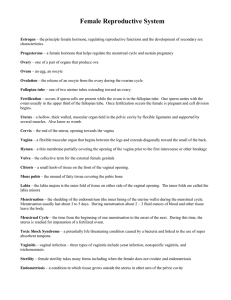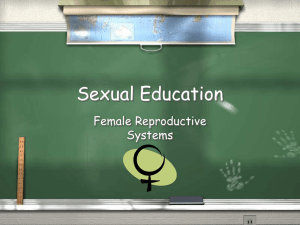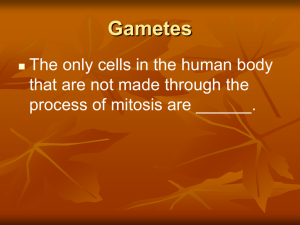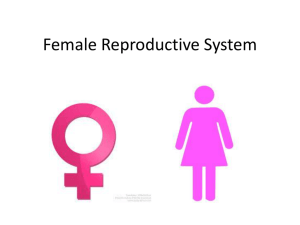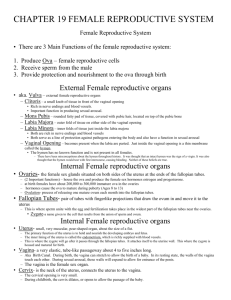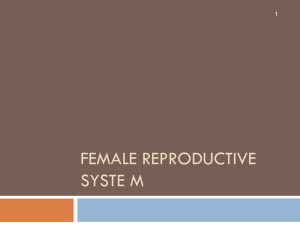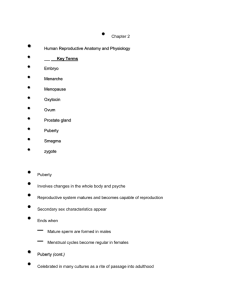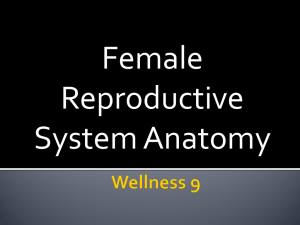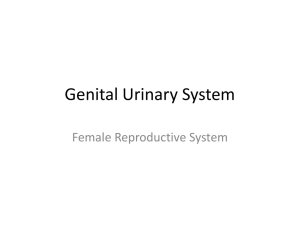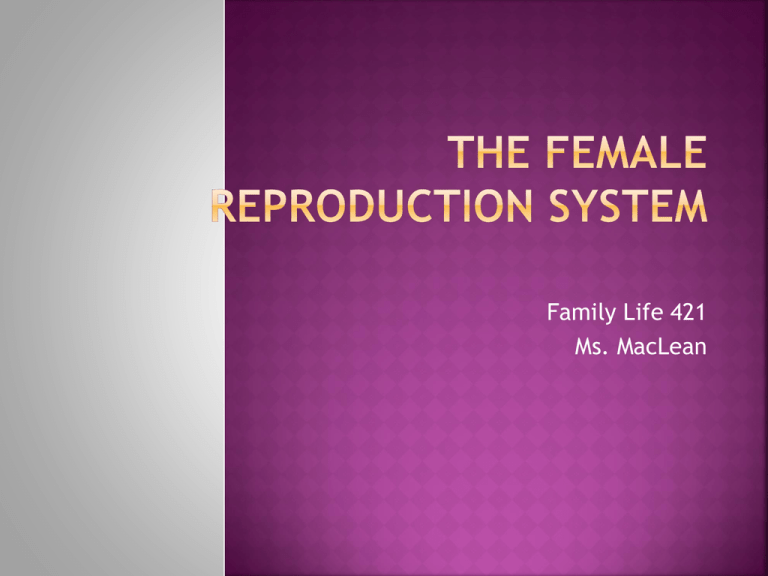
Family Life 421
Ms. MacLean
By
the end of this unit, you will be able
to:
discuss and describe the organs of the male
and female reproductive system;
identify the different parts of the male and
female reproductive system on a diagram;
discuss certain male and female health
concerns related to the reproductive
system.
Female Reproduction System
The
female reproductive system’s primary
function is for reproduction.
An
egg cell (ovum) is produced which, when
united with a sperm cell, will eventually
form a baby.
Although
the female has external and
internal reproductive organs, the organs of
the system are primarily internal.
The
external organs are called the vulva.
The
vulva consists of the:
Clitoris
Mons pubis
Labia majora (Outer lips)
Labia minora (Inner lips)
Vaginal opening
The
clitoris is a knob of tissue, located in
front of the vaginal opening.
The
clitoris has no reproductive function,
but is important in producing sexual arousal.
The
mons pubis is a rounded, fatty pad of
tissue, covered with pubic hair.
The
mons pubis is located on top of the
pubic bone.
The
labia majora (outer lips) is the outer
fold of tissue on either side of the vaginal
opening.
The
labia minora (inner lips) is the inner
folds of skin which are inside the labia
majora. The labia minora form a hood over
the clitoris.
The
functions of the labia are:
To protect against germs entering the body
For sexual arousal
The
vaginal opening is visible with the labia
are parted.
Vaginal Opening
The
internal organs are the:
Vagina
Uterus
Fallopian tubes
Ovaries
The
vagina is a tubelike passageway, about 4
to 5 inches long.
It
is also called the birth canal; it stretches
to allow for the birth of a baby.
The
vagina leads to the cervix (the neck of
the uterus).
The
cervical opening is very small, but during
child birth it opens (dilate) for the baby.
The
hymen is a thin membrane, located just
inside the vaginal opening.
The
hymen has no particular function and is
not present in all females.
There
are many myths related to the hymen,
but many are not true.
Some
women may feel discomfort with the
breaking of their hymen.
The
uterus is a strong, elastic muscle, about
the size of a fist.
The
primary function of the uterus is to hold
and nourish a fetus (developing baby).
On
each side of the uterus are the Fallopian
tubes.
Fertilization
of the ovum (the joining of a
sperm cell and egg cell) occurs in the
Fallopian tubes.
The
ovaries are the female sex glands on
both sides of the uterus.
The
function of the ovaries are:
Production of female sex hormones (estrogen and
progesterone)
House the egg cell (ovum)
Ovulation
is the process of an ovary
releasing a mature egg cell (ovum) into that
ovary’s Fallopian tube.
A
ovum can live for about two days in the
Fallopian tube.
If
sperm are present, one sperm will enter
the ovum. This is call fertilization.
Pregnancy begins at this point.
If
the ovum is fertilized, it moves into the
uterus and attaches to the lining.
The
ovum will develop into a baby while in
the uterus.
If
the ovum is not fertilized, it dies and
passes into the uterus.
The
uterine lining is not needed because
there is no pregnancy, so the uterine muscles
begin to contract and the lining of the uterus
is shed.
This
lining passes through the vagina and out
of the body during a process called
mestruation.
Menstruation
(also called a period) usually
takes 4 to 7 days, but can be shorter or
longer. Each female’s menstrual period is
different.
During
menstruation, the female loses
between 2 and 3 tablespoons of blood in
additional to the uterine lining (tissue).
Almost
all females being menstruating
between the ages of 10 and 15.
Hormones
control the menstrual cycle so
each female’s cycle is unique to her.
Menstruation Cycle
Because
the uterus contracts to break down
the lining, the female may experience
cramps.
Light
exercise, a warm bath, or a heating
pad will relax the muscles to assist with the
cramps.
Severe
cramps require medical attention.
Bathing
of the vaginal area is important, but
becomes even more important during
menstruation.
Sanitary
napkins or tampons must be used to
catch the menstrual flow, and must be
changed every 3 to 4 hours.
Tampons
left in for more than 4 hours
increases the risk of infection.
Women
have certain reproductive health
issues:
Premenstrual Syndrome (PMS)
Sterility
Breast Cancer
Premenstrual
Syndrome (PMS) refers to a
variety of symptoms females experience
during menstruation, including:
Nervous tension
Anxiety
Irritability
Bloating
Weight gain
Depression
Mood swings
Fatigue
The
causes of PMS are not fully understood,
but may be related to hormones or
nutritional deficiency.
Most
doctors recommend diet and life-style
changes.
PMS
sufferers must try to reduce stress, and
reduce their intake of sugar, salt, caffeine,
nicotine, and alcohol.
How to Relieve PMS Symptoms
Women
can become sterile through:
A blockage in one of both of the Fallopian tubes
The inability to ovulate
Endometriosis, a condition in which uterine
tissue grows outside the uterus, in the pelvic
cavity.
Breast
cancer is the second leading cause of
death of women after lung cancer (US).
Breast
cancer is not preventable, but it is
treatable and curable.
Females
with a family history of breast
cancer are twice as likely to develop this
cancer.
Women
should complete monthly self-breast
examinations.
Symptoms
of breast cancer (in women and
men) are:
Change in breast or nipple appearance
Lump or swelling in the breast
Lump under the armpit

